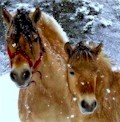Horses are prey animals with a well-developed fight-or-flight instinct. Their first response to threat is to startle and flee, although they are known to stand their ground and defend themselves or their offspring in cases where flight is not possible or when they young are threatened. They also tend to be curious. When startled, they will often hesitate and instant to ascertain the cause of their fright and may not always flee from something that they perceive as non-threatening. Through selective breeding, some horse breeds are quite docile, particularly certain large draft horses. However, most light riding breeds were developed for speed, agility, alertness, and endurance, natural qualities that extend from their wild ancestors.
Horses are herd animals, with a clear hierarchy of rank, led by a dominant animal (usually a mare). Horses are also social creatures that are able to form companionship attachments to their own species and to other animals, including humans. They communicate in various ways, including vocalizations such as nickering or whinnying, mutual grooming, and body language. Many horses will become difficult to manage if they are isolated. When this behavior occurs while being handled by humans, the horse is called "herd bound". However, through proper training, it is possible to teach any horse to accept a human as a type of companion, and thus be comfortable away from other horses.
Horse TemperamentHorses are mammals, and as such are all "warm blooded" creatures, as opposed to "cold blooded" creatures. However, these have developed a separate equine meaning to describe temperament, not body temperature. For example, the "hot bloods," such as racehorses, exhibit more sensitivity and energy, while the "cold bloods," such as most draft breeds are quieter, calmer creatures.
Horse BreedsHorses come in a wide range of heights, weights, and body types. Different breeds were developed with a specific "form" adapted to a particular "function" or type of work. For example, in terms of height, the largest members of some draft breeds can top 19 hands (76 inches or 2 meters), while the smallest miniature horse stands as 5.2 hands (22 inches or 0.56 meters), not significantly larger than a large dog. But height alone does not dictate function; a 17 hand Thoroughbred has a lean slime body type, weighing around 1,200 pounds with a "hot" temperament suitable for horse racing. In contrast, a 17 hand Shire has a heavy body, can weigh 2,000 pounds, has a very mild or "cold" temperament, and is suitable for farm work.
Horse CareHorses are grazing animals, thus their most important dietary need is for abundant good-quality forage from hay or pasture. A common guideline is that horses are able to consume dry feed of up to 2.5 percent of their own body weight daily. Some supplementation with concentrated feed such as grain may be added (not replacement for) pasture or hay, especially when the animal id active or working. Horses require a plentiful supply of clean water, a minimum of 10-12 gallons per day. Although horses are adapted to live outside, they require shelter from the wind and precipitation, which can range from a simple shed or shelter to an elaborate stable.
Horses require annual vaccinations to protect against various diseases, need routine hoof care by a farrier, and regular dental examinations from a veterinarian or a specialized equine dentist. If horses are kept inside in a barn, they require regular daily exercise for their physical health and mental well-being. When turned outside, they require well-maintained sturdy fences to be safely contained. Regular grooming is also helpful to help the horse maintain good health of the hair coat and underlying skin.
